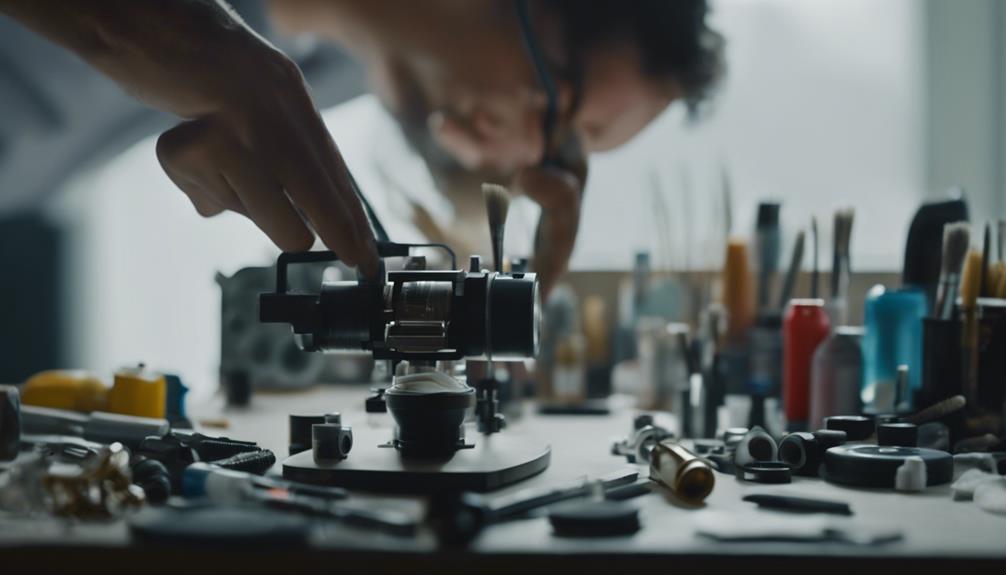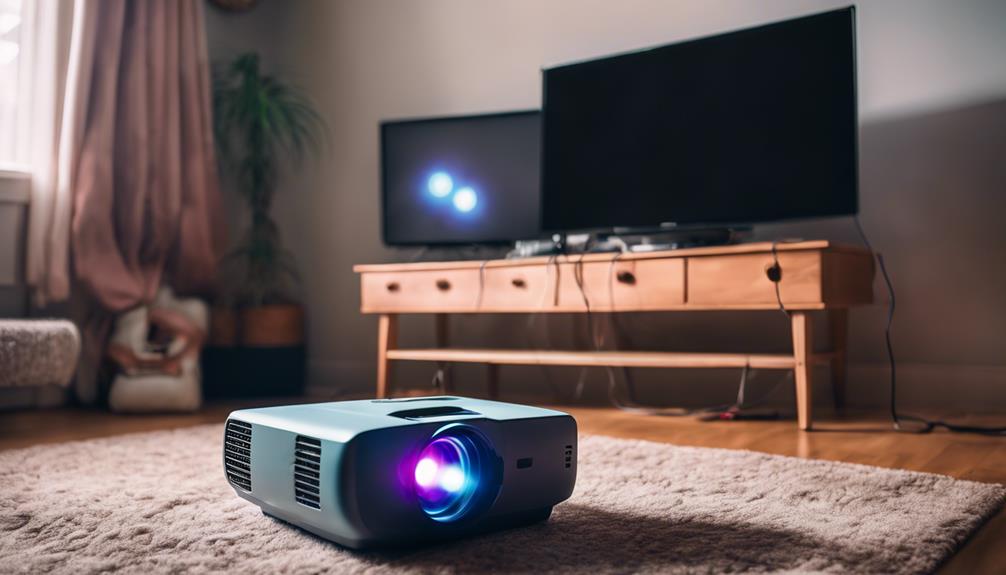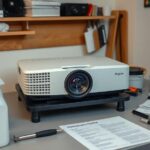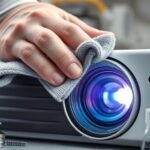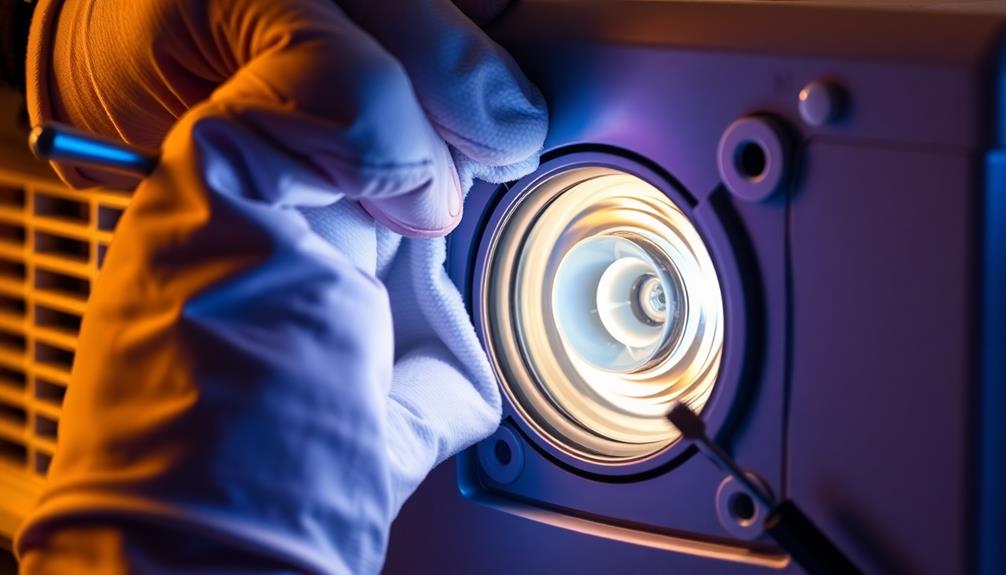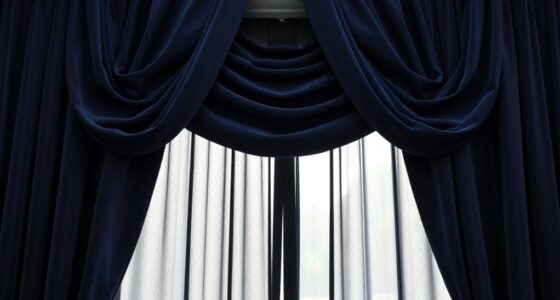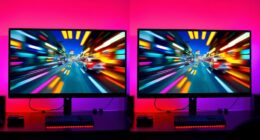To keep your projector in top shape, focus on regular cleaning, air filter maintenance, and proper ventilation. Wipe the exterior with a soft cloth and clean the lens with compressed air to maintain image clarity. Check and clean the air filter every few months to prevent overheating. Guarantee at least 12 inches of space around the projector for ventilation. Store it in a cool, dry place, and always use surge protectors for safe power supply management. By following these simple steps, you can enhance your projector's performance and longevity. There's more to discover to guarantee your device runs smoothly.
Key Takeaways
- Regularly clean the projector lens and air filter to prevent dust buildup and overheating, enhancing performance and image quality.
- Ensure proper ventilation by maintaining at least 12 inches of unobstructed space around the projector for optimal airflow.
- Use surge protectors and reliable power sources to safeguard against electrical damage and fluctuations.
- Monitor operating temperatures and maintain a clean environment to prevent overheating and prolong device lifespan.
Regular Cleaning Techniques
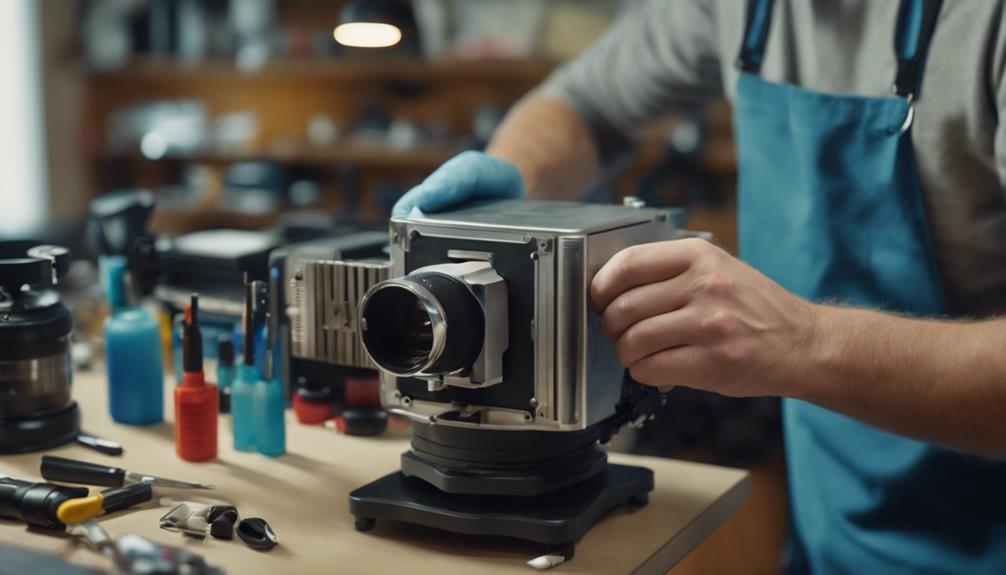
Keeping your projector clean is crucial for maintaining its performance and longevity. Regular cleaning techniques can make a significant difference in how your device operates.
Start by wiping the exterior with a soft, dry cloth to remove dust and fingerprints. This simple step not only keeps your projector looking neat but also helps prevent dust from entering the device.
Next, focus on the lens. Use a lens brush or compressed air to gently clean it, avoiding direct contact to protect the lens's coating. Make it a habit to schedule cleaning intervals based on how often you use your projector—aim for at least once every few months to guarantee peak performance.
Don't forget about the ventilation ports. Inspect and clean them regularly to prevent dust buildup, which can hinder airflow and lead to overheating. If your projector has an air filter, remember to clean it as per the manufacturer's instructions. Use a soft brush or compressed air for this task, and replace it if it's heavily soiled.
Following these maintenance tips will keep your projector functioning at its best for years to come.
Air Filter Maintenance
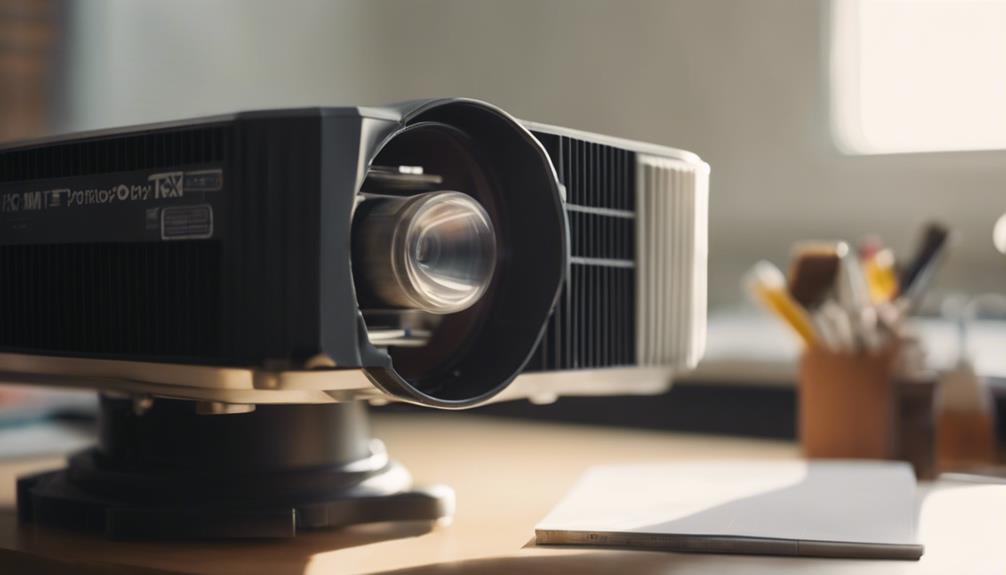
Regularly checking and cleaning your projector's air filter is vital for preventing overheating and guaranteeing peak performance. Ideally, you should inspect the air filter every few months for dirt and clogs. A clean air filter promotes ideal airflow, which is essential for cooling your projector's internal components.
To maintain your air filter, use a soft brush or compressed air for light cleaning. If it's heavily soiled, rinse it with water, but make sure it dries completely before reinstalling. This prevents moisture from damaging the projector.
You should also replace the air filter according to the manufacturer's recommendations or when it looks visibly dirty. This guarantees efficient cooling performance, helping to prevent overheating that could shorten your projector's lifespan or cause significant damage to its internal components.
After cleaning or replacing the air filter, double-check its proper installation. A well-installed air filter is key to keeping dust out and maintaining your projector's performance.
Temperature Control Strategies
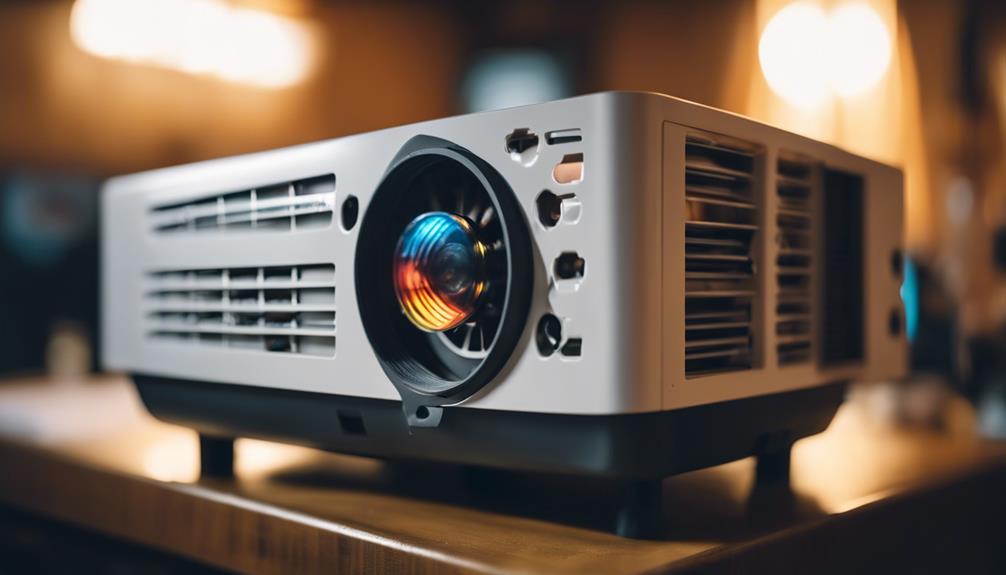
To keep your projector running smoothly, you need to guarantee proper ventilation around it.
Regularly monitor the operating temperature to catch any issues before they cause damage.
With the right temperature control strategies, you can extend your projector's lifespan and maintain its performance.
Proper Ventilation Importance
Proper ventilation is essential for projectors, as they produce considerable heat during operation and require effective airflow to prevent overheating. To guarantee proper airflow, make sure there's at least 12 inches of unobstructed space around your projector's vents. This allows for effective air circulation and heat dissipation, which is crucial for maintaining optimal performance.
Regularly inspect and clean the ventilation ports to prevent dust accumulation. Dust can restrict airflow, leading to overheating and potentially damaging your projector over time. Keeping these areas clean is a simple yet significant step in projector maintenance.
Additionally, consider using external cooling fans or placing your projector in a well-ventilated area to enhance temperature control. This can notably improve cooling efficiency and prolong your projector's lifespan.
By prioritizing proper ventilation and heat management strategies, you'll guarantee that your device operates smoothly and lasts longer, allowing you to enjoy crisp images without interruptions.
Monitor Operating Temperature
Monitoring your projector's operating temperature is essential for preventing overheating and guaranteeing peak performance during use. By keeping an eye on temperature levels, you can avoid costly repairs and maintain your device's longevity.
Additionally, proper projector maintenance tips can help you keep your device running smoothly. Here's how to effectively monitor and manage temperature:
- Verify there's adequate space around the projector for proper airflow.
- Regularly check the projector's temperature during operation to catch any issues early.
- Invest in cooling fans if you're using the projector in an enclosed space.
- Clean air intake and exhaust vents frequently to prevent dust buildup.
Environmental Considerations
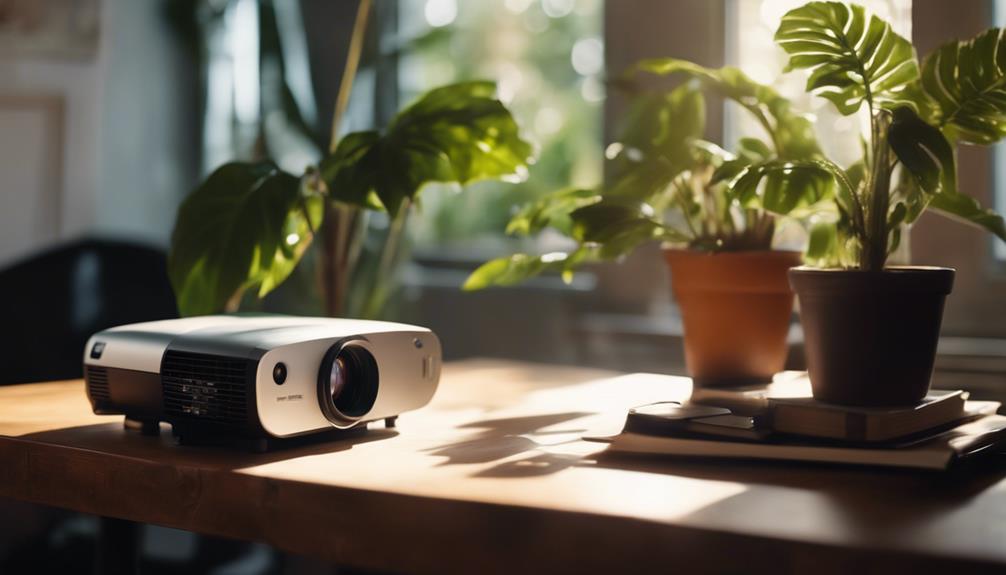
To keep your projector running smoothly, it's important to maintain a clean, dust-free environment.
Dust can accumulate and affect the internal components, so regular cleaning and monitoring of humidity levels are essential.
Clean, Dust-Free Environment
Creating a clean, dust-free environment for your projector greatly boosts image clarity and overall performance. Dust can accumulate on lenses and sensitive components, leading to reduced functionality and visual output.
To keep your projector running smoothly, consider these best practices:
- Regularly clean the surrounding area to prevent dust buildup.
- Use air purifiers to filter out airborne particles.
- Keep curtains closed to minimize external dust intrusion.
- Avoid using your projector in smoky or cluttered spaces.
Monitor Humidity Levels
Keeping humidity levels between 30% and 50% is essential for maintaining your projector's performance and longevity. High moisture can lead to internal damage and mold growth, which can seriously affect your device. To keep track of humidity, invest in a hygrometer to monitor the environment where your projector operates.
| Humidity Level | Effects on Projector |
|---|---|
| 0% – 29% | Risk of static damage |
| 30% – 50% | Peak performance |
| 51% – 70% | Increased condensation risk |
| 71% – 85% | Potential shorts inside |
| 86%+ | Severe moisture damage |
If you find humidity levels are consistently high, using a dehumidifier can help, especially in damp areas like basements. Additionally, regularly check and clean your projector's air filter. Clogged filters can restrict airflow and worsen humidity issues, leading to overheating and reduced performance. By keeping an eye on humidity and maintaining airflow, you can extend your projector's lifespan and enjoy peak viewing experiences.
Power Supply Management

Managing your projector's power supply is vital for maintaining its performance and longevity. To guarantee your device runs smoothly, always connect it to a reliable power source that meets the manufacturer's voltage specifications. This helps avoid damaging internal components.
Here are some important tips to remember:
- Use surge protectors to guard against power fluctuations.
- Regularly inspect power cables for wear or damage.
- Avoid unapproved extension cords or power strips to prevent inadequate power supply.
- Power down and unplug the projector when not in use.
Handling and Transport Tips
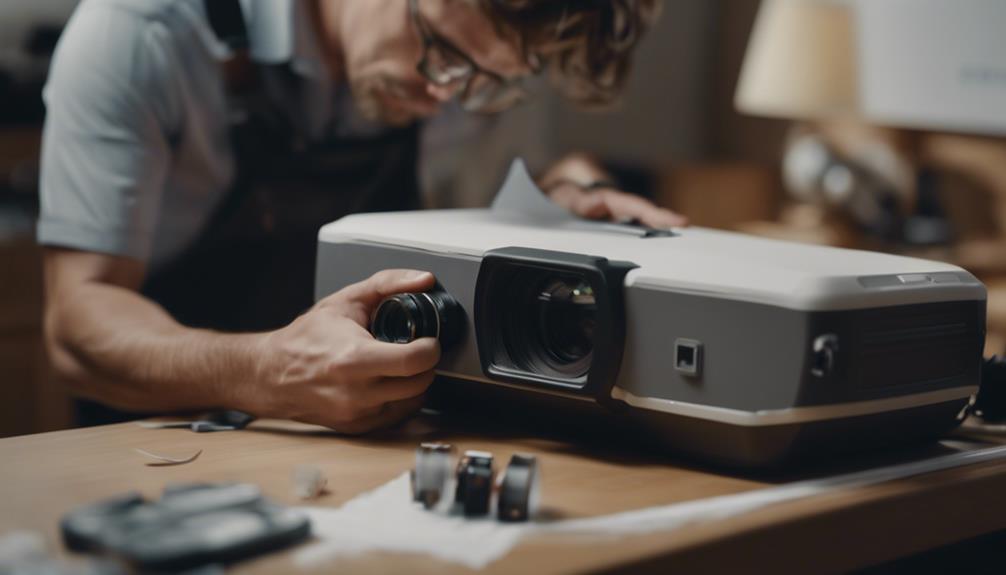
When you handle and transport your projector, always power it down and unplug it to prevent electrical hazards and potential damage.
Make sure to disconnect the power cord before lifting the device. When you lift the projector, use both hands to support it from the bottom. This technique helps avoid strain on the device and reduces the risk of dropping it.
To store your projector safely, use a dust-proof carrying case or the original box with protective padding. This reduces the chance of impacts and dust accumulation during transport. If you're storing it upright, keep the lens facing up to prevent scratches or damage to the lens surface.
Avoid exposing your projector to extreme temperatures or humidity while transporting it, as these conditions can affect its internal components and overall performance. Always check the weather before heading out, and consider using additional padding if you're worried about bumps and jolts during transport.
Troubleshooting Common Issues
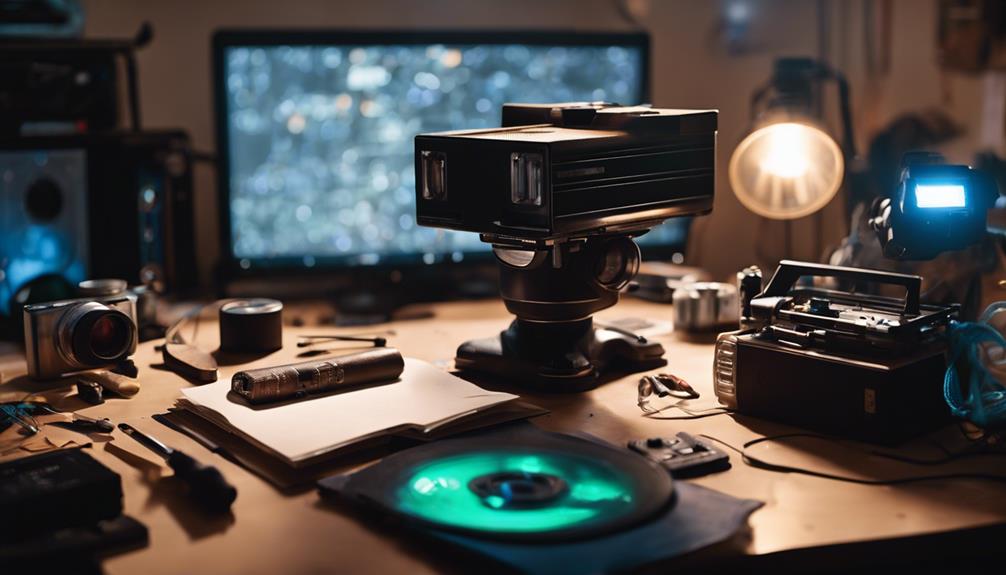
Troubleshooting common projector issues can save you time and guarantee smooth presentations or movie nights. When your projector's not performing, here's how to tackle some frequent problems:
- No Power: Confirm the power cord's securely plugged in and check if the outlet's working.
- Blurry Image: Adjust the focus ring and verify the projector's positioned correctly from the screen.
- Image Quality Issues: If colors look off, recalibrate the settings or check the lamp for replacement.
- Overheating Issues: Inspect ventilation ports for dust particles and clean the air filter to improve airflow.
Storage Best Practices
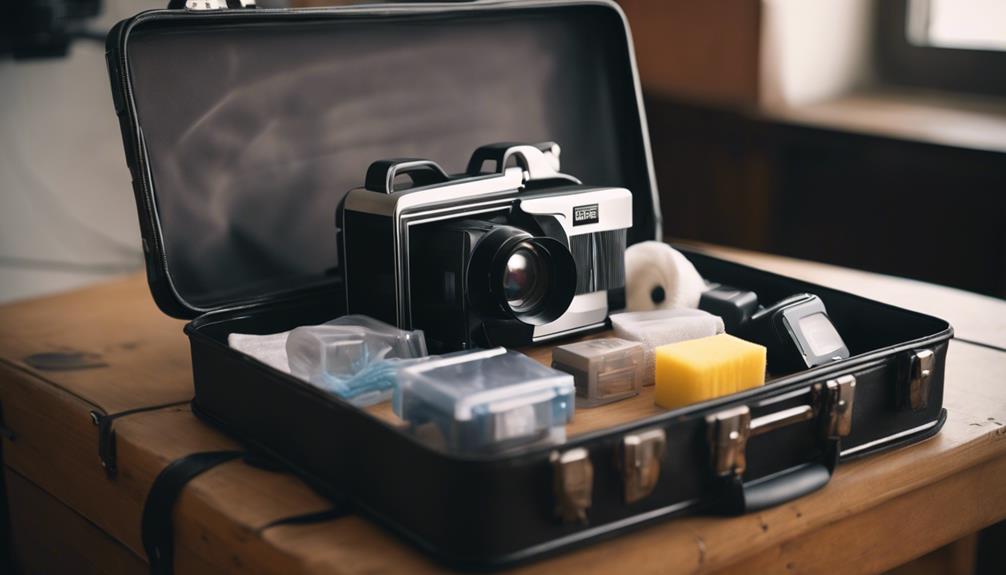
Proper storage of your projector can greatly extend its lifespan and maintain peak performance, especially after you've resolved any issues. Following these storage best practices will help you keep the projector in prime condition.
| Best Practice | Purpose | Tips |
|---|---|---|
| Store in a cool, dry place | Prevent overheating | Avoid direct sunlight |
| Use the original box | Protect from movement | Consider foam-lined containers |
| Keep upright with lens up | Prevent lens pressure | Minimize risk of damage |
| Clean before storage | Prevent dust buildup | Use a microfiber cloth |
| Use a dust-proof bag | Prevent dust accumulation | verify it's sealed properly |
When maintaining your projector, always power down and unplug it before storage. Cleaning agents can damage sensitive parts, so stick to gentle methods. By following these practices, you can prevent dust and debris from affecting the internal parts of your projector. Regularly adhering to these guidelines will guarantee that your device remains in top shape and ready for your next presentation or movie night.
Importance of Routine Maintenance
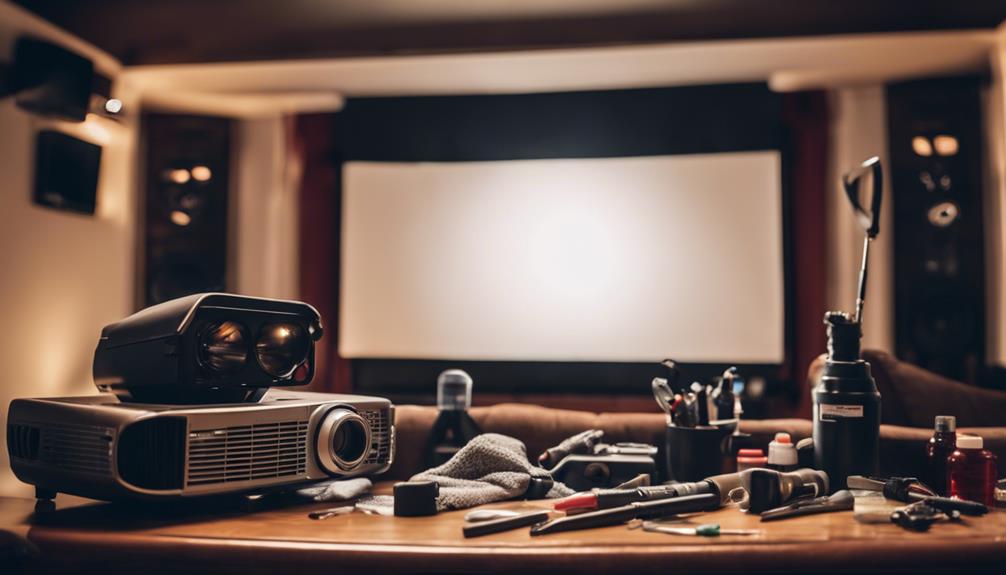
Routine maintenance is essential for keeping your projector in top shape and enhancing image quality.
By regularly cleaning filters and lenses, you not only prolong the device's lifespan but also guarantee vibrant visuals each time you use it.
Neglecting maintenance can lead to dim images and overheating, so staying on top of upkeep is key.
Enhances Image Quality
Regular maintenance greatly enhances image quality, ensuring your projector delivers sharp, vibrant visuals every time you use it. By taking simple steps, you can considerably improve your viewing experience and avoid frustrating issues like blurry images or color distortion.
Here are some key maintenance tips to keep in mind:
- Regularly clean the lens with a lens brush to prevent dust buildup, which can impair clarity.
- Check and replace the air filter to improve airflow and cooling efficiency, reducing the risk of overheating.
- Adjust projector settings and perform routine calibrations to achieve ideal performance and color accuracy.
- Control humidity levels in your environment, as excessive moisture can lead to image degradation.
Prolongs Device Lifespan
Maintaining your projector with consistent care can greatly prolong its lifespan and guarantee reliable performance for years to come. Regular projector maintenance is essential to extend the life of your device. By preventing dust accumulation and guaranteeing efficient airflow, you can greatly reduce the risk of overheating, one of the leading causes of projector failure.
Make it a habit to perform regular cleaning and inspection of internal components. This proactive approach allows you to catch minor issues before they escalate into major problems. Additionally, replacing the air filter according to the manufacturer's recommendations helps keep your projector running at peak performance and minimizes downtime.
Projectors that receive consistent upkeep can last between 5 to 15 years, depending on how often you use them and the care they receive. In contrast, neglected devices often fail within just 3 to 5 years. By committing to routine maintenance, you not only enhance your projector's reliability but also guarantee it serves you well for many years to come.
Enhancing Projector Performance

To enhance your projector's performance, clean the lens with a microfiber cloth to keep dust from degrading image quality. A clean lens guarantees that you maintain bright, crisp visuals during your presentations or movie nights.
Don't stop there; tackle other aspects to guarantee peak performance:
- Regularly check and clean the air filter to prevent overheating.
- Keep the projector in a well-ventilated area, allowing proper airflow.
- Update the firmware frequently to fix known issues and enhance functionality.
- Use high-contrast screens to improve image clarity.
Frequently Asked Questions
What Is the Maintenance of Projectors?
To maintain projectors, you should regularly clean the exterior and lens, check air filters for clogs, guarantee proper ventilation, secure power connections, and schedule routine maintenance checks to enhance reliability and performance.
What Is the Maintenance on Epson Projector?
Think of your Epson projector as a delicate flower; it needs care to flourish. Regularly clean the air filter, update firmware, and wipe the lens. Store it safely, and it'll shine brightly for you.
How Do You Fix a Lopsided Projector?
To fix a lopsided projector image, adjust its feet for leveling, use keystone correction in the menu, and make certain it's aligned perpendicularly to the screen. Also, clean the lens for best projection quality.
How Do I Fix My Projector Screen Alignment?
About 30% of viewers notice image distortion immediately. To fix your projector screen alignment, make certain it's positioned perpendicularly, adjust zoom and focus, and use keystone correction for a clear, properly sized image.
Conclusion
To keep your projector running smoothly, don't overlook routine maintenance—it's not just a nice-to-have, it's essential.
Think of it like caring for a classic car; regular checks and cleanings keep it in peak condition and extend its lifespan.
By following the tips outlined, you'll enhance performance and avoid common pitfalls that could lead to costly repairs.
So, roll up your sleeves and give your projector the TLC it deserves!
